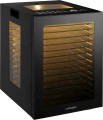Drying levels
The number of separate trays on which food can be placed during drying.
The design of the trays in food dryers can vary. Typically, they consist of separate closed compartments, but another option is a common chamber with shelves (refer to the "Location of the fan (heater)" section for more information). Regardless of the specific design, the trays are positioned vertically, with multiple trays or "floors" in modern food dehydrators. The most modest option is actually
3 trays;
4 trays — also quite a small number;
5-tray dehydrators are the most popular; noticeably less common models with
6 trays or
8 trays; and in individual devices
9 or more trays can be provided (12, and sometimes 20).
Using multiple trays or "floors" in a food dehydrators ffers several advantages. It allows for increased capacity while maintaining a compact width and depth for the entire device. The more tiers there are, the smaller the area of each individual tray becomes, enabling a smaller overall width and depth of the dehydrator. This is particularly beneficial when space is limited on a table or surface, but there is ample vertical space available. Additionally, having multiple trays allows for simultaneous drying of different types of products with varying drying times. By using ce
...rtain techniques, individual compartments and shelves can be removed without having to turn off the device. However, it's important to note that increasing the number of levels in the device affects its height and cost, reduces the capacity of each individual tray, and necessitates the use of more powerful fans to ensure even heat distribution.
It's important to note that the presence of numerous trays does not necessarily indicate a powerful or spacious food dehydrator. This design can be found in compact models as well. Devices with 3-4 tiers often do not significantly differ in capacity, although there may be exceptions to this.
At the same time, there are also models whose equipment with trays significantly exceeds the number of drying levels. But our paragraph indicates how many levels (trays) can be used simultaneously when drying.Tray size
Horizontal dimensions of one dryer tray.
For round models, this paragraph usually indicates the diameter (for example, “Ø250”), for other cases — the length and width. Anyway, the information about the size allows you to estimate the total area and, accordingly, the capacity of the device. At the same time, note that a larger size affects the dimensions and weight of the structure, and also requires more heating power (ceteris paribus).
Power consumption
Rated power consumed by the dryer during operation.
This parameter is usually selected by manufacturers depending on the volume of the dryer: the larger the device, the more power is needed to effectively heat the working chamber. At the same time, models with the same volume may differ in power consumption. In such cases, it is worth considering that a higher power reduces the heating time, but affects the price of the device.
Tray material
The material from which the complete trays of the dryer are made.
—
Plastic. Inexpensive, but at the same time very practical material. In terms of strength and overall reliability, the plastic is inferior to metal, however, during normal use of the dryer, this difference is not noticeable. In addition, if such trays are made in the form of complete compartments, their walls can be made transparent so that you can observe the contents without interrupting the process and without knocking down the temperature regime. However the transparent walls gradually become cloudy due to the low resistance of plastic to scratches — however, it takes a lot of time for this moment to become a serious inconvenience. Thus, most modern dryers use plastic trays.
—
Stainless steel. The main advantages of metal trays are strength and resistance to overheating. On the other hand, these advantages rarely turn out to be significant, and steel is more expensive than plastic. In addition, if metal trays are made in the form of separate compartments, they are opaque, and to check the condition of the products, you will have to open these compartments, lowering the temperature and disrupting the process. . For models with a rear fan (see above), this point is not relevant — they usually have a transparent door; however, such devices are not cheap. Thus, this tray material is rare nowadays — mainly among advanced dryers.

